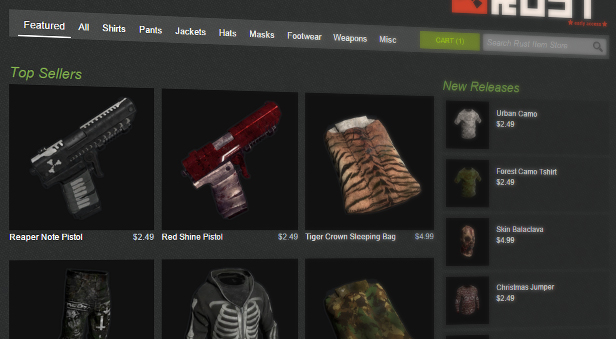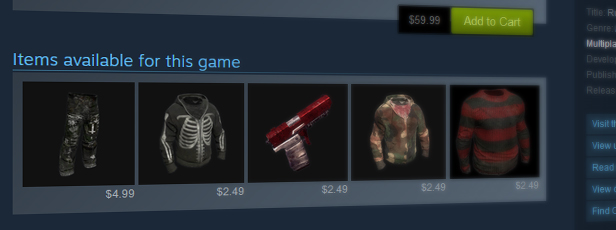Steamworks Documentation
- Documentation Home Page
- Getting Started
-
Store Presence
- Applications
- Coming Soon
- Developer And Publisher Homepages
- Early Access
- Explain Your Editions
- Franchise Pages
- Free To Play Games
- Graphical Assets - Overview
- Livestreaming
- Localization and Languages
- Pre-Purchasing on Steam
- Pricing
- Promo Event Tools, Rules, and Guidelines
- Release Dates
- Release Options
- Release Process
- Removing a product from Steam
- Review Process
- Season Passes
-
Steam China
- Steam Tags
- Store Page, Building and Editing
- Testing On Steam
- Top Sellers Lists
- Trailers
- Updating Your Game - Best Practices
- User Reviews
-
Features
- Anti-cheat and Game Bans
- Common Redistributables
- Enhanced Rich Presence
- Game Notifications
- Microtransactions (In-Game Purchases)
- Multiplayer
- Stats and Achievements
- Steam Audio
- Steam Cloud
- Steam Cloud Play (Beta)
- Steam Community
- Steam DRM
- Steam Error Reporting
- Steam Families
- Steam HTML Surface
-
Steam Input
- Action Manifest Files
- Action Set Layers
- Activators
- Browsing Configurations
- General Concepts
- Getting Started for Developers
- Getting Started for Players
- In-Game Actions File
- Input Source Modes
- Input Sources
- Legacy Mode Bindings
- Mode Shifting
- Mouse Regions
- Radial Menus
- Steam Input Devices
- Steam Input Gamepad Emulation - Best Practices
- Templates for In-Game Actions Files
- Touch Menus
- Uploading Steam Input Configs to Steam Workshop
- Steam Inventory Service
- Steam Keys
- Steam Leaderboards
- Steam Overlay
- Steam Playtest
- Steam Remote Play
- Steam Screenshots
- Steam Timelines
- Steam Voice
- Steam Workshop
- User Authentication and Ownership
- Virtual Reality
- Finance
-
Sales and Marketing
- Advertising on Steam
- Best Practices, Marketing
- Community Moderation
- Curators and Curator Connect
- Discounting
- Events and Announcements Tools
- Features And Tools, Marketing
- Followers
- Google Analytics
- Points Shop Items
- Profile Features
- Steam Branding Guidelines
- Steam Community Items
- Store and Platform Traffic Reporting
- Store Widget
-
Upcoming Steam Events
- Steam Next Fest
-
Steam Themed Sale Events
- Steam Animal Fest 2025
- Steam Board Game Fest 2026
- Steam Deckbuilders Fest 2026
- Steam Detective Fest 2026
- Steam Hidden Object Fest 2026
- Steam Horse Fest 2026
- Steam House & Home Fest 2026
- Steam Medieval Fest 2026
- Steam Ocean Fest 2026
- Steam PvP Fest 2026
- Steam Sports Fest 2025
- Steam Tower Defense Fest 2026
- Steam Typing Fest 2026
- Steam Winter Sale 2025
- UTM Analytics
- Visibility on Steam
- Wishlists
- Steamworks SDK
- Web API Overview
- Accessibility Features
-
Steam Deck
- Getting your game ready for Steam Deck
- How to debug Windows games on Steam Deck
- How to load and run games on Steam Deck
- Social Media Templates
- Steam Deck and Proton
- Steam Deck Brand Guidelines and Logos
- Steam Deck Compatibility Review Process
- Steam Deck Developer Kits
- Steam Deck FAQ
- Steam Deck SVG Line Art
- Steamworks Virtual Conference: Steam Deck - Nov 12th 2021
- Steam PC Café Program
-
Steamworks API Reference
- ISteamApps Interface
- ISteamClient Interface
- ISteamController Interface (Deprecated)
- ISteamFriends Interface
- ISteamGameCoordinator Interface
- ISteamGameServer Interface
- ISteamGameServerStats Interface
- ISteamHTMLSurface Interface
- ISteamHTTP Interface
- ISteamInput Interface
- ISteamInventory Interface
- ISteamMatchmaking Interface
- ISteamMatchmakingServers Interface
- ISteamMusic Interface
- ISteamNetworking Interface
- ISteamNetworkingMessages Interface
- ISteamNetworkingSockets Interface
- ISteamNetworkingUtils Interface
- ISteamParties Interface
- ISteamRemotePlay Interface
- ISteamRemoteStorage Interface
- ISteamScreenshots Interface
- ISteamTimeline
- ISteamUGC Interface
- ISteamUser Interface
- ISteamUserStats Interface
- ISteamUtils Interface
- ISteamVideo Interface
- SteamEncryptedAppTicket
- steamnetworkingtypes.h
- steam_api.h
- steam_gameserver.h
-
Steamworks Web API Reference
- IBroadcastService Interface
- ICheatReportingService Interface
- ICloudService Interface
- IEconMarketService Interface
- IEconService Interface
- IGameInventory Interface
- IGameNotificationsService Interface
- IGameServersService Interface
- IInventoryService Interface
- ILobbyMatchmakingService Interface
- IPartnerFinancialsService Interface
- IPlayerService Interface
- IPublishedFileService Interface
- ISiteLicenseService Interface
- ISteamApps Interface
- ISteamCommunity Interface
- ISteamEconomy Interface
- ISteamGameServerStats Interface
- ISteamLeaderboards Interface
- ISteamMicroTxn Interface
- ISteamMicroTxnSandbox Interface
- ISteamNews Interface
- ISteamPublishedItemSearch Interface
- ISteamPublishedItemVoting Interface
- ISteamRemoteStorage Interface
- ISteamUserAuth Interface
- ISteamUser Interface
- ISteamUserStats Interface
- ISteamWebAPIUtil Interface
- IStoreService Interface
- IWorkshopService Interface
Steam Inventory Item Store
Overview
The Steam Item Store is a customizable Steam-hosted web store for selling items defined in the Steam Inventory Service. If you have items defined with prices in the Steam Inventory Service, then you can simply enable the Item Store to have a place that lists your purchasable items.
Once enabled for your Steamworks game, this store will provide a set of web pages hosted by Steam that lists out the priced items you’ve defined in the Steam Inventory Service for your game. Through these pages, customers can browse, filter, and search through the available items for the game, add them to a cart within your store, and purchase using the Steam Wallet.
Setting Up
You'll need to start by having a functional Steam Inventory Service implementation. Once you've configured your Inventory Service and have defined at least one item that have prices defined, then you can enable the Steam Item Store for your application.- Make sure Inventory Service is enabled for your app. See Steam Inventory Service for details.
- Then go to the 'Edit Store' section for your app and find the Item Store tab.
- Check the box to enable your Item Store. There are a few ways you can customize your store (see below for details), but they are all optional.
Once enabled for your own game, you can easily open your Item Store page from within your game by launching the Steam Overlay and passing it this page’s URL. Or you can link to this page from your own website or store page. Your top-selling items will even automatically appear on your base game’s store page to help customers find your items.

Testing your Item Store
Your item store will only be visible to members of your Steamworks partner by default. As well, any purchases you make will go through the microtransaction "sandbox," which will not deduct any funds from the user's Steam Wallet. Previous to release, you will need to use the beta=1 parameter in any urls for the item store (e.g. https://store.steampowered.com/itemstore/<appid>/?beta=1 ).Some common issues developers run into:
- No items show up - This can happen if no prices have been set for your item definitions.
- Item Store is not visible - Your Item Store will only be visible to everyone if your app has been released and you've manually set the Item Store live, which you can do from the store page settings for your app.
Customizing your Item Store
We’ve made it easy to customize your store with a background image as well as options for a grid or list view and the ability to define tags that can appear as tabs to be used to filters for the items shown. As an example, you can see in the screenshot above that the developers of Rust have customized their Steam Item Store page with a custom background and tabs for easily finding different types of items.Naming your store
You can enter a name for your store and localized versions of that name for display in different languages. If left blank, we'll just show your app name as the name.Display format
You can pick whether to show items in a grid or in a list.Background
You can upload a custom background image, which includes your product branding if you wish to change the overall feel of the store. This image should be 1920px x 1080px and the edges should fade to a solid background color which you can also specify.Top-level filters
You can associate a top-level filter with one or more tags, which are delimited by the ";" character. Tags are specified in the item definition schema in thestore_tags field in your Steam Inventory Service ItemDefs.Detail Page
You can display additional images on the detail page for an item by specifying them in thestore_images field in your Steam Inventory Service ItemDefs. See Steam Inventory Service schema.



